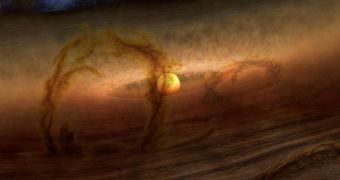A team of astronomers at the NASA Jet Propulsion Laboratory (JPL) in Pasadena, California, recently used the American space agency's Spitzer Space Telescope to image a number of protoplanetary disks around nearby, young stars. The investigation finally revealed why these structures give off a lot more infrared light than they theoretically should, a question that has puzzled experts since 2006.
Protoplanetary disks are gas and dust rings that develop around very young, freshly-coalesced stars and are made up of any excess material that did not collapse inside the celestial orb from the original molecular cloud that spawned it. In time, the material in these disks tends to clump up, forming meteors, comets, asteroids, and planets.
When these structures were first observed in infrared, astronomers found that they are heated from within and made to glow in IR by heat from their parent stars and by starlight. However, studies conducted with Spitzer's keen eyes found an additional amount of infrared light, whose origins could not be readily explained. The new study suggests that magnetic storms are responsible for these emissions.
This conclusion is based on the 3D models of protoplanetary disks researchers created for the new study. The team says that gas and dust gets trapped inside magnetic loops and remains suspended above the plane of the disk. This material absorbs additional starlight, which it then re-emits as IR light.
“If you could somehow stand on one of these planet-forming disks and look at the star in the center through the disk atmosphere, you would see what looks like a sunset,” JPL investigator Neal Turner explains. Magnetic activity also provides a new view of how material in these disks is stirred so that planetary formation can occur.
Turner and his colleagues liken the activity of magnetic loops above planet-forming disks to what happens on the surface of the Sun when magnetic field lines create vast solar prominences that eventually flare up some impressive loops. These phenomena usually throw massive amounts of matter, light, and radiation in the solar system.
“The starlight-intercepting material lies not in a halo, and not in a traditional disk either, but in a disk atmosphere supported by magnetic fields. Such magnetized atmospheres were predicted to form as the disk drives gas inward to crash onto the growing star,” Turner explains.
Over the next few years, the JPL team wants to use telescopes such as the Stratospheric Observatory for Infrared Astronomy (SOFIA), the Atacama Large Millimeter/submillimeter Array (ALMA), and the upcoming NASA James Webb Space Telescope to refine their new 3D protoplanetary disk models.

 14 DAY TRIAL //
14 DAY TRIAL //